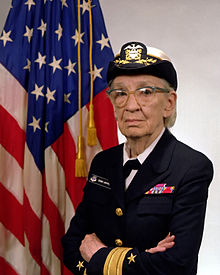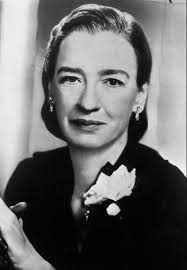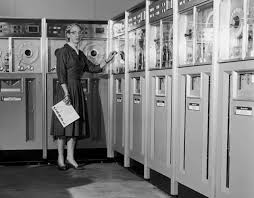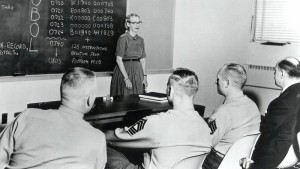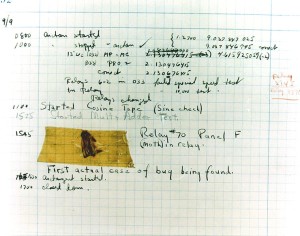Our Mother, who art in Pentagon,
Grace Hopper be thy name.
Thy audit come, World Wide will be done
In COBOL as it is in Standard.
Spare us this day our waily Fed,
And give us our passes
As we forgive those which fail against us,
And lead us not into validation
But deliver us from JTSA. Amen!
The last few weeks have been a little bloody, so let’s turn away from the battlefield and instead focus on a woman who had a wildly successful career in the Navy, and whose work you have directly benefited from. This week, courtesy of the Suggestion Box, we’ll focus on Rear Admiral Grace Hopper, who contributed more than most people can understand to the field of computer science.
Born Grace Brewster Murray to a fairly well-off family in 1906 in New York City, the Murray family staunchly supported the education of women. Grace attended Vassar as an undergraduate, then went on to earn a Ph.D. in mathematics from Yale at age 28 (the 11th woman to do so). After graduating, she married Vincent Hopper (a professor of comparative literature) and began teach math at her alma mater, Vassar.
Grace took a unique approach to teaching math, having her students write out solutions to equations in essay format. When her students complained that they were math majors and not English majors for a reason, Grace insisted that one had to understand the concept before one could write coherently about it. She surely didn’t intend such at the time, but her idea has become one of the basic tenets of computer science and good programming.
However, Grace wasn’t quite content with where life had taken her. Teaching didn’t exactly thrill her, and her marriage wasn’t doing well, either. By all accounts Mr. Hopper was a fine man, just not someone suited for Grace. In 1940, she took a partial leave of absence so she could devote more time to studying math. But whatever plans Grace had for her life after that were disrupted by an event which changed the trajectories of many American lives: the Japanese army attacked Pearl Harbor.
Grace, responding to the government’s call for enlistment, promptly quit her job, divorced her husband and enlisted in the Naval Reserves – the only department willing to take a 36 year-old woman. They were well rewarded when Grace graduated from the Naval Academy at the top of her class in 1944. She expected to be assigned to cryptography and code-breaking, but, as it turned out, the Allies already had someone working on that. (Side note: I really feel like the world missed out on something special because, as far as I can tell, Grace Hopper and Alan Turing were never in a room together).
Instead, Grace was sent to Harvard, where she began working with Howard Aiken on the Mark I, one of the world’s first true computers. Using Charles Babbage’s work from the previous century on his Difference Engine, Grace and Howard worked together to develop the world’s first programming manual. Grace came to identify with Babbage’s own assistant, Lady Ada Lovelace, the world’s first programmer.
While working on the Mark I and the programming manual, Grace realized an inherent obstacle in working with computers. Machines can only understand 0 and 1 (or, more specifically ‘on’ and ‘off’). Programming the Mark I required writing in machine code, which was almost pure, highly conceptual math. A fine thing if one happens to be a math genius in a room with other math geniuses, but Grace recognized this restriction would ensure computers stayed rare and inaccessible to most people.
And so she proceeded to make a few critical advances in computer science. The first was a natural outgrowth of her work as a mathematics professor in the 30s – the development of programming languages based more on English than on pure math. This ensured one did not have to be a math genius to work with computers, only be very good at it. Grace developed first the FLOW-MATIC language, which was then refined into COBOL, a language still in use today.
Her other great advance was creating a way for the programmer and machine to communicate. Computers couldn’t understand FLOW-MATIC or COBOL directly, but writing in machine code was difficult and time-consuming. And so Grace wrote a new type of program: the compiler, which takes programmer’s code and translates it into machine code. Every computer program you’ve ever used was first written by a programmer and then run through a compiler. Every program, from your favorite video game to the browser you’re using to read this.
Her advances didn’t stop there – Grace was one of the first people who proposed creating networks of computers which could all access the same information, and also developed testing standards to help ensure uniformity across programming languages.
She also found the first computer bug, which was, quite literally, a bug! A moth flew into the hardware of the Mark I, where it caused several programming errors. And in that poor moth’s honor, unforeseen programming errors have been called bugs.
She attempted to retire three times – in 1966, 1971 and 1986. For the first two times, she eventually found a reason to come back to work; but the Navy insisted she retire for good in 1986. She promptly went back to work as a consultant, speaking about her work to various groups of people. She was proud of her naval career, and wore her full dress uniform whenever possible.
She died of natural causes at age 85, in 1992, and was laid to rest with full military honors at Arlington National Cemetery.
By all accounts, Grace was a fun, slightly mischievous woman. She lived by the adage ‘It’s better to ask forgiveness than permission,’ and knew how to handle herself and get what she wanted from a group of men. She demanded respect, but was just as respectful to others – though she didn’t let that stop her from playing the occasional prank on her coworkers!
Grace’s heroism is different from the heroism this blog has heretofore focused on. While the women I’ve covered previously have picked up weapons and gone to war when things got sticky, Grace led no armies, only departments. Every morning, she got up and went to work, and did it day after day after day. She worked slowly and steadily to overcome obstacles and problems, blazing a trail for others to follow. And though she was neither pirate nor rebel nor queen, she nevertheless sets her own example for the modern woman to follow.
Technically, she hasn’t shown up in pop culture frequently, but only because she’s a very recent lady and appears in our culture in other ways. She’s a figure of admiration, especially for women in programming and computer science, and many groups, awards and scholarships for women in computers are named after her. Five Thirty-Eight has just released a short documentary about her.
Resources
